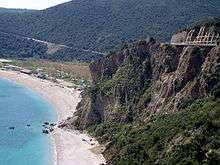Adriatic Highway

The Adriatic Highway (Croatian: Jadranska magistrala) is a road that stretches along the eastern coast of the Adriatic Sea and is part of the European route E65. The road passes principally through Croatia, with smaller stretches through Bosnia and Herzegovina and Montenegro. It is still a two-lane road for almost its entire length, with the exception of intermittent short dual-carriageway sections near Trogir, Kaštela and Split. The dual carriageway is planned to be expanded to span Trogir and Omiš. Completion of the Adriatic Ionian motorway is proposed in order to replace the Adriatic highway as a high-performance road transport route along the Adriatic coast.[1]
Sections
Adriatic Highway runs along the east coast of the Adriatic Sea and passes through three countries: Croatia, Bosnia and Herzegovina and Montenegro. Most of the highway is located in Croatia.
Croatian section
Croatian section of the highway is officially named D8 state road (Croatian: Državna cesta D8),[2] and it runs from Slovenian border crossing via Rijeka via Senj, Zadar, Šibenik, Split, Opuzen and Dubrovnik to the border with Montenegro at Karasovići.[3][4] Most of the D8 is still a two-lane road, excepting rare four-lane stretches. Total length of the road through Croatia is 643.1 kilometres (399.6 mi).
Until recent times the highway has been the primary route connecting Adriatic coastal parts of Croatia. Since the 2000s multilane motorways have taken over most of its traffic, and yet more motorways are still being built along the coast. The motorways parallel to the road are A7 (Rupa border crossing-Sveti Kuzam), A6 (Rijeka-Bosiljevo) and A1 (Bosiljevo-Zadar-Split-Ploče).[3] Since Adriatic Highway closely follows the well-indented Croatian coastline, travel is considerably longer and less safe compared to the motorways because of numerous blind curves and at-grade intersections. D8 state road is still popular as an alternative to the tolled highways, so the road carries fairly constant traffic during most of the year. The traffic intensifies in the summer, because of substantial traffic to touristic destinations.
The D8 section from Rijeka to Senj experiences heavy traffic in particular because many motorists are unwilling to take the longer route along A6 and A1, even though the motorway route normally requires shorter travel time. This problem used to be further exacerbaced before 2009 when A6 still had slow semi-highway parts on the Rijeka-Bosiljevo route. This section will remain congested at peak intervals until eventual completion of A7 motorway between Rupa and Žuta Lokva.
Since the parallel A1 motorway currently terminates at the Ploče interchange,[5] approximately 20 km (10 mi) northwest of Ploče, tourists heading south generally switch to Adriatic Highway. Further 30 km (20 mi) after Ploče drivers also encounter a small strip of Bosnia and Herzegovina territory around town of (Neum) between Klek and Zaton Doli.[4] After that section, the highway continues to Dubrovnik close to the coastline.
Upon the completion of A7 and A1 the part of Adriatic Highway spanning from Ploče to Dubrovnik are planned to be upgraded to an expressway bypassing Neum in Bosnia and Herzegovina entirely via a series of tunnels and bridges, Pelješac Bridge being the most notable among them. The possibility of other upgrades remains open.
East of Dubrovnik the road passes by Dubrovnik Airport and reaches the border with Montenegro at Karasovići (Debeli Brijeg on the Montenegrin side).[4]
Bosnia-Herzegovina section
The highway passes through a small strip of Bosnia and Herzegovina territory at Neum. The border crossings are at Neum 1 (with Klek on the Croatian side) to the west of Neum, and Neum 2 (with Zaton Doli on the Croatian side) to the east. Travellers not going to Bosnia and Herzegovina usually aren't inspected by customs officers. The road from Neum to the rest of Herzegovina is in a bad shape. A highway entirely through Croatia (Pelješac Bridge) was planned but is now on hold in favour of upgrading the streets around Neum.
Montenegrin section
Within Montenegro, the two-lane road runs from Herceg Novi through Tivat, Budva, Petrovac, Sutomore, and Bar to Ulcinj. The traditional highway runs around the Kotor Bay through Kotor, but through traffic uses the ferry connection across the Verige Strait between Herceg Novi and Tivat.
The Montenegrin section, albeit as narrow as Croatian, still remains the only feasible route along the Adriatic coast. No litoral motorways are planned in Montenegro yet.
There are two major roads from the Adriatic Highway to inland Montenegro – at Budva, via Cetinje, and at Sutomore, via Sozina tunnel. It merges with Croatian road network at the Debeli Brijeg border crossing near Herceg Novi, and ends east of Ulcinj. From Herceg Novi to Haj Nehaj, near Sutomore, it is the part of European routes E65/E80, which then transforms into European route E851.
Verige bridge spanning the Bay of Kotor and part of the Adriatic Highway is planned to be built in the future.
See also
Sources
- ↑ Radimir Čačić (November 2006). "Adriatic-Ionian Transport Corridor on the territory of the Republic of Croatia" (PDF). Regional Economic Forum Southeast Europe. Archived from the original (PDF) on December 29, 2009. Retrieved September 8, 2010.
- ↑ "Snow and gale force winds block traffic between Dalmatia and the northern Croatia". Večernji list (in Croatian). December 15, 2009.
- 1 2 "Odluka o razvrstavanju javnih cesta" [Decision on categorization of public roads]. Narodne novine (in Croatian). May 10, 2013.
- 1 2 3 "Map of border crossings and customs office areas" (PDF). Customs Administration of the Republic of Croatia (in Croatian). March 6, 2008.
- ↑ "Regulation on motorway markings, chainage, interchange/exit/rest area numbers and names". Narodne novine (in Croatian). April 24, 2003.
